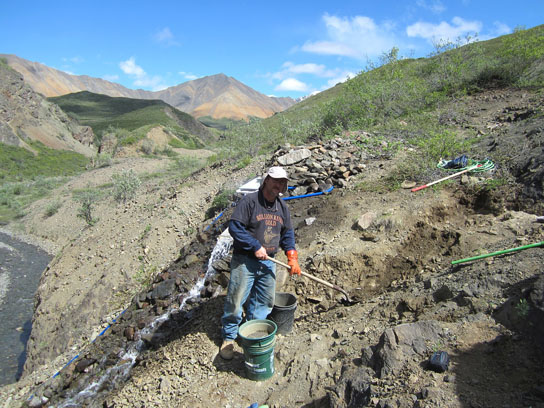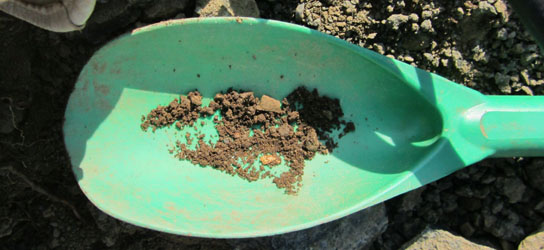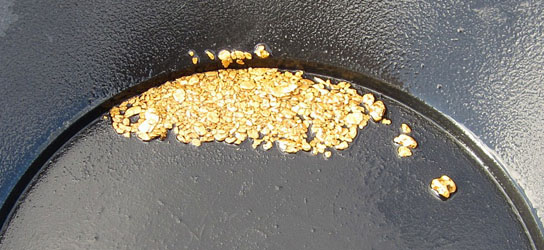The prospecting potential of the mining district where I visited included metal detecting for nuggets, but because there was plenty of water, the possibilities also included sluicing or high banking as well as suction dredging. The ground here was suitable for both pulse induction as well as VLF machines, most being fairly low mineralization, with some smaller areas strongly mineralized because of different underlying rocks. I brought both types of detector technology with me, as I wanted to be fully prepared. Although some larger nuggets have been found here, most of the gold is less than a half gram in weight. The gold deposits were well washed with nearly all the gold found within just the first few inches on top of bedrock. I spent considerable time detecting the bedrock on the bench areas above the creek that the miners had worked by hydraulic methods decades ago.
The first afternoon I was out prospecting I tested several areas of exposed bedrock with my metal detector, and soon got a very sweet sounding response. I looked down and a few inches away from my coil was a visible nugget wedged in a small crack in the bedrock. It was sort of unusual because the detector was responding to a spot a few inches away and clearly not from the visible nugget that I could see with my eyes. I tested the visible nugget with the detector and did get a weak response (it was edge up in a crack), but a stronger response was coming the spot next to it. Well I dug up both targets and they were gold. As I was digging them, I actually spotted a third small piece of gold. So I dug up all the gravel at that spot and ran it through a sluice box and got several more pieces of gold and some fines which I hadn't seen initially.
 The author digging out the alluvial gravels of a nugget patch found with a detector. The alluvial gravels of this small area yielded nearly two ounces of fine gold after more than 60 nuggets were removed by detector.
The author digging out the alluvial gravels of a nugget patch found with a detector. The alluvial gravels of this small area yielded nearly two ounces of fine gold after more than 60 nuggets were removed by detector.
When you see visible gold like that, you know that there will be some pieces that the metal detector won't be able to see, so it's a smart idea to dig up any gravel and run it through pan or sluice. One hot spot that Steve originally found yielded over 60 nuggets with a metal detector, but when we dug out the whole area and ran it through a highbanker sluice, it yielded almost two ounces of gold.
 Here is a small Alaskan nugget freshly found with my detector. It weighs around a half a gram.
Here is a small Alaskan nugget freshly found with my detector. It weighs around a half a gram.
There are still small patches of ground there which run better than 1 ounce per cubic yard, left behind by the old-timers because they were too small to mess with. These make for excellent targets both for metal detecting as well as sluicing and high banking. These hotspots were scattered all over, but had to be found by sampling with a metal detector. Much of the gold I recovered during my trip came from these small hotspots where the pioneer miners had failed to clean the bedrock thoroughly. When I found more than just one or two nuggets in a small area with my detector, I would simply dig all the material at that spot and run it through a sluice box. The fine gold in the gravel which was too small to hear with my metal detector would then be recovered in the sluice. With the high price of gold, recovering those extra grams of fine gold in every patch was well worth the effort.
 Here is a half ounce of gold recovered by sluicing the alluvial gravels of a patch – after it had already been detected and a number of nuggets removed. The patch was found by detecting.
Here is a half ounce of gold recovered by sluicing the alluvial gravels of a patch – after it had already been detected and a number of nuggets removed. The patch was found by detecting.
In the end, it was an amazing adventure in a place with a lot of history and great gold. The mountains were beautiful and majestic. It's the kind of place a lot of guys can only dream about, so I have to admit I was very lucky to be invited to join Steve and George there. My final take was just over 2 ounces, Steve's total was close to 4 ounces, and George got about an ounce and three quarters. So for the three of us, our total was very close to 8 ounces for three weeks time which is a pretty good take.
Chris Ralph
Chris Ralph’s Prospecting Encyclopedia




















Comments
To make comments you must be logged in, please note comments will not display immediately due to moderation
Thanks for a great read I really enjoyed the story.
JP